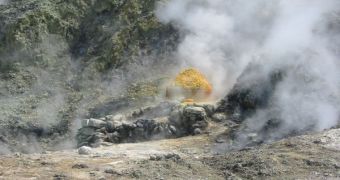It would appear that Italian people have a thing for constructing their cities inside or very close to active or dormant volcanoes. This is known for Vesuvius, the mountain that buried the Roman cities of Pompeii and Herculaneum, which is located six miles (nine kilometers) away from Naples. Nearly three million people are in direct danger if the volcano, one of the most dangerous in the world today, erupts. But a larger one lies nearby that basically dwarfs Vesuvius in size, NewScientist reports.
Once known as the Phlegraean Fields, or the entrance to Hades (Hell) for ancient Romans, Campi Flegrei is a giant volcanic crater that collapsed on itself more than 39,000 years ago, following a massive eruption. It now represents the target for the Campi Flegrei Deep Drilling Project, which seeks to drill boreholes inside the volcano, and check to see what the situation inside is. If the mountain is to erupt, it would cover most of Europe in a thick layer of ash, ending civilization on the continent. The repercussions of such an explosion would be far-reaching.
The fact that the volcano has no cone has led people to settle around, as well as directly on top of it. “Most of the metropolitan area of Naples is located within the caldera,” the leader of the CFDDP, Giuseppe De Natale, explains. He is also an expert with the Vesuvius Observatory in Naples, a division of the National Institute of Geophysics and Volcanology's (INGV). This means that, when the volcano first erupts, it will throw its first gases and magma straight through the streets of Naples, without warning.
Geologists are very worried about this volcano, and have named it one of the highest risk areas in the world today. Some 4,000 years ago, when the mountain also showed signs of activity, a phenomenon known as crustal uplift occurred. This means that the ground around the mountain started rising several meters before the blasts. This is precisely what is happening at this point, and the goal of the Project is to assess the exact conditions below the ground. Scientists with the CFDDP say that their work is absolutely crucial in creating plans that would mitigate the effects of a possible eruption.

 14 DAY TRIAL //
14 DAY TRIAL //